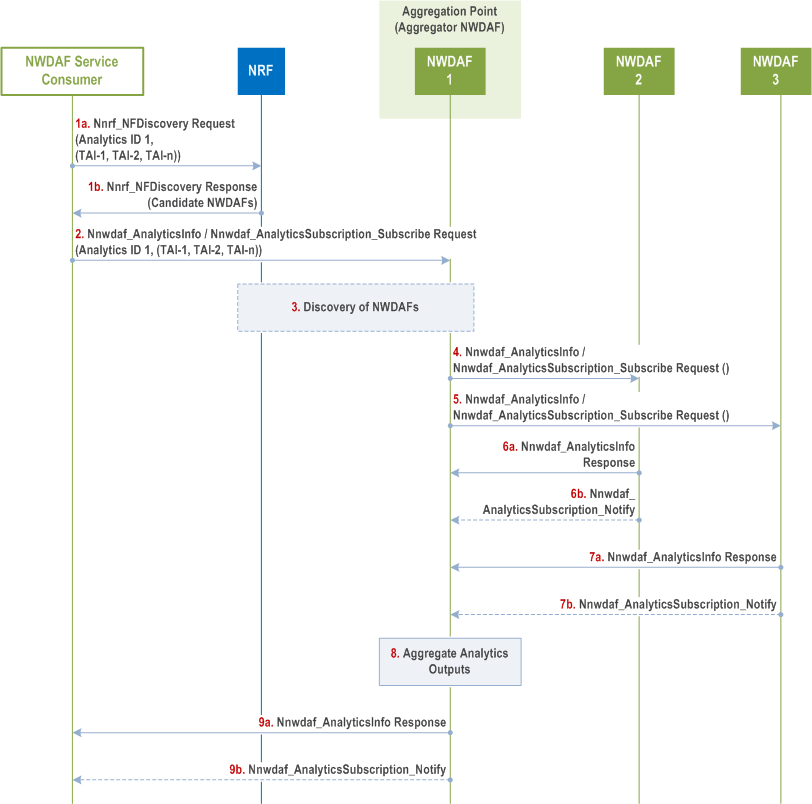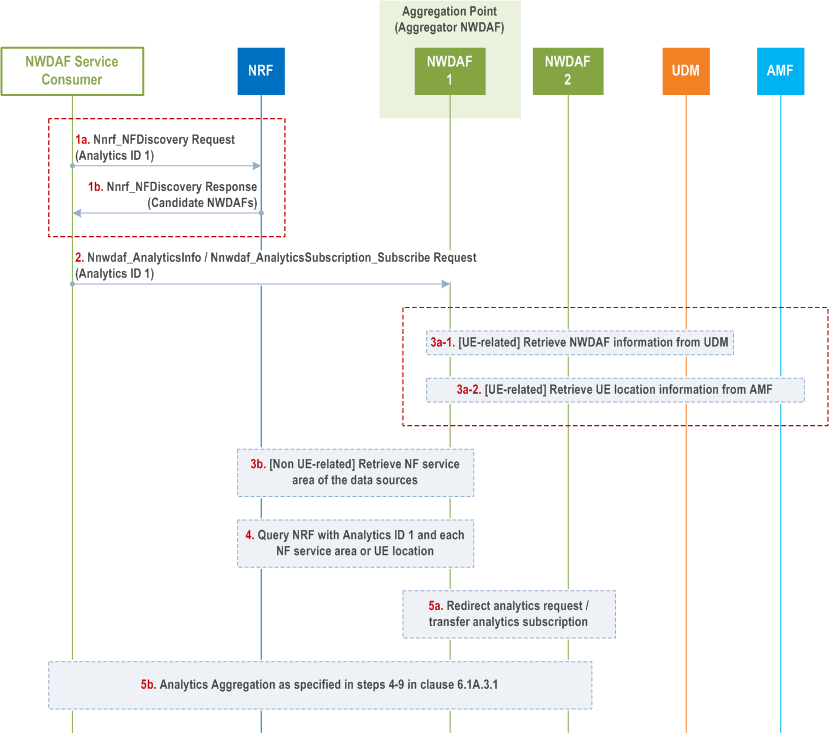Content for TS 23.288 Word version: 19.1.0
1…
4…
5…
5A…
6…
6.1.3
6.1.4…
6.1.4.4…
6.1.5…
6.1A…
6.1B…
6.1B.2.3…
6.1C
6.2…
6.2.3…
6.2.6…
6.2.6.2
6.2.6.3…
6.2.6.3.3
6.2.6.3.4
6.2.6.3.5
6.2.6.3.6…
6.2.7…
6.2.8…
6.2.9…
6.2.13…
6.2A…
6.2B…
6.2B.3
6.2B.4…
6.2C…
6.2D…
6.2E…
6.2F…
6.2H…
6.2H.2.2…
6.2H.2.3…
6.2H.2.4…
6.3…
6.4…
6.5…
6.6…
6.7…
6.7.3…
6.7.4…
6.7.5…
6.8…
6.9…
6.10…
6.11…
6.12…
6.13…
6.14…
6.16…
6.17…
6.18…
6.19…
6.20…
6.21…
6.22…
6.23…
7…
7.4…
7.7…
7.9…
8…
9…
10…
6.1A Analytics aggregation from multiple NWDAFs
6.1A.1 General
6.1A.2 Analytics Aggregation
6.1A.3 Procedure for analytics aggregation
6.1A.3.1 Procedure for analytics aggregation with Provision of Area of Interest
6.1A.3.2 Procedure for Analytics Aggregation without Provision of Area of Interest
...
...
6.1A Analytics aggregation from multiple NWDAFs |R17| p. 58
6.1A.1 General p. 58
In a multiple NWDAF deployment scenario, an NWDAF instance may be specialized to provide Analytics for one or more Analytics IDs. Each of the NWDAF instances may serve a certain Area of Interest or TAI(s). Multiple NWDAFs may collectively serve the particular Analytics ID. An NWDAF may have the capability to support the aggregation of Analytics (per Analytics ID) received from other NWDAFs, possibly with Analytics generated by itself.
The procedure for analytics aggregation from multiple NWDAFs is as defined in clause 6.1A.3.
6.1A.2 Analytics Aggregation p. 58
The analytics aggregation from multiple NWDAFs is used to address cases where an NWDAF service consumer requests Analytics ID(s) that requires multiple NWDAFs to collectively serve the request. Analytic aggregation applies to scenarios where NWDAF service consumer requests or subscribes to analytics information with or without provisioning Area of Interest.
Aggregator NWDAF or aggregation point:
- Is an NWDAF instance with additional capabilities to aggregate output analytics provided by other NWDAFs. This is in addition to regular NWDAF behaviour such as collecting data from other data sources to be able to generate its own output analytics.
- Is able to divide the area of interest, if received from the consumer, into sub area of interest based on the serving area of each NWDAF to be requested for analytics and then send analytics requests including the sub area of interest as an Analytics Filter to corresponding NWDAFs. The Aggregator NWDAF may maintain information on the discovered NWDAFs, including their supported Analytics IDs, NWDAF Serving Areas, etc.
- Has "analytics aggregation capability" registered in its NF Profile within the NRF.
- Supports the requesting and exchange of "Analytics Metadata Information" between NWDAFs when required for the aggregation of output analytics. "Analytics Metadata Information" is additional information associated with the requested Analytics ID(s) as defined in clause 6.1.3.
- Supports dataset statistical properties, output strategy and data time window parameters per type of analytics (i.e. Analytics ID) as defined in clause 6.1.3.
-
Stores the NF Profile of the NWDAF instances, including "analytics aggregation capability" for Aggregator NWDAFs and "analytics metadata provisioning capability" when supported by the NWDAF.
-
Returns the NWDAF(s) matching the attributes provided in the Nnrf_
NFDiscovery_ , as specified in clause 5.2.7.3 of TS 23.502.Request
-
Returns the NWDAF(s) matching the attributes provided in the Nnrf_
- Requests or subscribes to receive analytics for one or more Analytics IDs, as specified in clause 6.1 of the present document.
- Does discovery and selection as defined in clause 6.3.13 of TS 23.501 to identify NWDAFs with analytics aggregation capability and other capabilities (e.g. providing data/analytics for specific TAI(s)).
- Can differentiate and select the preferred NWDAF in case multiple NWDAFs are returned in the NWDAF discovery response based on its internal selection criteria (considering the registered NWDAF capabilities and information in NRF or UDM).
6.1A.3 Procedure for analytics aggregation p. 59
6.1A.3.1 Procedure for analytics aggregation with Provision of Area of Interest p. 59
The procedure depicted in Figure 6.1A.3.1-1 is used to address cases where an NWDAF service consumer requests Analytics ID(s) for an Area of Interest that requires multiple NWDAFs that collectively serve the request.

Step 1a-b.
NWDAF service consumer discovers the NWDAF as specified in clause 5.2. When NRF is used, NRF may return multiple NWDAF candidates matching the requested capabilities, area of interest and supported Analytics ID(s). NWDAF service consumer selects an NWDAF (e.g. NWDAF1) with analytics aggregation capability (i.e. Aggregator NWDAF), based on its internal selection criteria, considering registered NWDAF capabilities and information in NRF including the Supported Analytics Delay per Analytics ID (if available).
Step 2.
NWDAF service consumer invokes Nnwdaf_AnalyticsInfo_Request or Nnwdaf_AnalyticsSubscription_Subscribe service operation from the selected Aggregator NWDAF (e.g. NWDAF1). In the request, NWDAF service consumer provides Analytics ID(s) (e.g. Analytics ID 1) Analytics Filter Information (area of interest, e.g. TAI-1, TAI-2, TAI-n, if known to the NWDAF service consumer), Target of Analytics Reporting as defined in clause 6.1.3. It may also provide "time when analytics information is needed" (e.g. T1). It is expected that T1 is equal or greater than the Supported Analytics Delay per Analytics ID (if available) of the Aggregator NWDAF. Otherwise, the aggregator NWDAF may reject the analytics request or analytics subscription.
Step 3.
On receiving the request in step 2, Aggregator NWDAF (e.g. NWDAF1), based on e.g. configuration, queries to NRF including the Real-Time Communication Indication per Analytics ID and queries to UDM for checking which NWDAF(s) is serving the Target of Analytics Reporting. Considering the request from the NWDAF service consumer (e.g. Analytics Filter Information, T1, etc.) and Supported Delay per Analytics ID per NWDAF instance (when Real-Time Communication Indication was included), Aggregator NWDAF determines the other NWDAF instances that collectively can cover the area of interest indicated in the request (e.g. TAI-1, TAI-2, TAI-n).
Step 4-5.
Aggregator NWDAF (e.g. NWDAF1) invokes Nnwdaf_AnalyticsInfo_Request or Nnwdaf_AnalyticsSubscription_Subscribe service operation from each of the NWDAFs discovered/determined in step 3 (e.g. NWDAF2 and NWDAF3).
The request may optionally indicate "analytics metadata request" parameter to the determined NWDAFs (e.g. NWDAF-2 and/or NWDAF3), when analytics metadata is supported by these NWDAFs.
The request or subscription to the determined NWDAFs (e.g. NWDAF2 and/or NWDAF3) may also include the dataset statistical properties, output strategy and data time window. This indicates to the determined NWDAFs that the Analytics ID output shall be generated based on such parameters when requested.
If "time when analytics information is needed" (T1) was provided in step 2, the Aggregator NWDAF shall also provide a "time when analytics information is needed" to the determined NWDAFs, with a smaller value compared with T1 (e.g. T2).
Step 6-7a-b.
The determined NWDAFs (e.g. NWDAF-2 and/or NWDAF3) reply or notify with the requested output analytics.
If "analytics metadata request" was included in the request received by such NWDAF (in steps 4-5), the NWDAF additionally returns the "analytics metadata information" used for generating the analytics output as defined in clause 6.1.3.
If the determined NWDAFs (e.g. NWDAF 2 and/or NWDAF 3) cannot reply or notify with the requested output analytics before the expiry of T2, they may send an error response or error notification to the Aggregator NWDAF including a "revised waiting time".
Step 8.
Aggregator NWDAF (e.g. NWDAF1) aggregates received Analytics information, i.e. generates a single output analytics based on the multiple analytics outputs and, optionally, the "analytics metadata information" received from the determined NWDAFs (e.g. NWDAF2 and NWDAF3).
The Aggregator NWDAF (e.g. NWDAF1) may also take its own analytics for TAI-n into account for the analytics aggregation.
Step 9a-b.
Aggregator NWDAF (e.g. NWDAF1) sends a response or notifies to the NWDAF service consumer the aggregated output analytics for the requested Analytics ID.
If the Aggregator NWDAF (e.g. NWDAF 1) cannot reply or notify with the requested output analytics before the expiry of T1 or anticipates that it cannot reply or notify with the requested output analytics before the expiry of T1 (e.g. due to error notification in step 6-7a-b), it may send an error response or error notification to the NWDAF service consumer including a "revised waiting time". The NWDAF service consumer may optionally use the "revised waiting time" to update the "time when analytics information is needed" parameter (i.e. T1) for future analytics requests/subscriptions to the same Aggregator NWDAF as defined in clause 6.2.5.2.
6.1A.3.2 Procedure for Analytics Aggregation without Provision of Area of Interest p. 61
The procedure depicted in Figure 6.1A.3.2-1 is used to address cases where an NWDAF service consumer requests Analytics ID(s) without providing an Area of Interest, but requires multiple NWDAFs to collectively serve the request.

Step 1.
Depending on the discovered NWDAF instance(s), there can be two cases:
This step is a NWDAF discovery procedure without providing any area of interest. The service consumer discovers an aggregation NWDAF (e.g. NWDAF1) as specified in clause 5.2. When NRF is used, NRF may return multiple NWDAF candidates matching the requested capabilities and supported Analytics ID(s).
Depending on the requested Analytics ID, the NWDAF service consumer, e.g. based on internal logic, can be able to determine which NWDAF should be selected for providing the required data analytics. If not, the NWDAF service consumer should select a NWDAF with large serving area from the candidate NWDAFs which supports analytics aggregation, e.g. NWDAF1.
Step 2.
NWDAF service consumer sends Analytics information or analytics subscription request to the aggregator NWDAF, i.e. NWDAF1 in the Figure 6.1A.3.2-1. In the request, NWDAF service consumer provides the requested Analytics ID(s), e.g. Analytics ID 1.
The NWDAF service consumer may also provide "time when analytics information is needed" (e.g. T1). It is expected that T1 is equal or greater than the Supported Analytics Delay per Analytics ID of the Aggregator NWDAF (if available). Otherwise, the aggregator NWDAF may reject the analytics request or analytics subscription.
Once receiving the request, the Aggregator NWDAF1 may decide to subscribe data analytics from other NWDAF instances which can provide the requested data analytics. Based on the Analytics ID, there are two cases for the Aggregator NWDAF1 to subscribe data analytics from other NWDAF instances.
Step 3a.
If the data analytics requires UE location information, e.g. for the Analytics IDs "UE Mobility", "Abnormal behaviour", or "User Data Congestion", then:
Step 3b.
- 3a-1: (optional) The Aggregator NWDAF1 queries UDM to discover the NWDAF serving the UE, if it is supported.
- 3a-2: If step 3a-1 is not supported, was not executed, or did not return a suitable NWDAF serving the UE, the Aggregator NWDAF1 determines the AMF serving the UE as specified in the clause 6.2.2.1, then requests UE location information from the AMF to be used in the query to NRF in step 4.
If the data analytics does not require to collect UE location information, e.g. for the Analytics IDs "Service Experience", "NF load information", or "UE Communication", the Aggregator NWDAF1 can determine the NFs to be contacted for data collection as specified in clause 6.2.2.1 and then it can retrieve NF service area for each of the data source NFs from NRF.
Step 4.
(conditional) With the data obtained in step 3, the Aggregator NWDAF1 queries the NRF for discovering the required NWDAF, by sending an NF discovery request which may include UE location (e.g. TAI-1) or NF serving area (e.g. TAI list-1) as a filter to NRF and obtains candidates target NWDAF(s) that can provide the required analytics. This step is skipped if a suitable NWDAF was discovered in step 3a-1. Additionally the Aggregator NWDAF1 may include in the NF discovery request the Real-Time Communication Indication per Analytics ID to request Supported Delay per Analytics ID per NWDAF instance.
Step 5a.
If a single target NWDAF (e.g. NWDAF2) can provide the requested analytics data, the Aggregator NWDAF (e.g. NWDAF1) can redirect the Nnwdaf_AnalyticsInfo_Request to that target NWDAF or request an analytics subscription transfer to that target NWDAF, depending on the type of the analytics request/subscription received by the NWDAF Service Consumer.
Step 5b.
If the Aggregator NWDAF decides to request data analytics from one or more target NWDAFs, the steps 4-9 of the analytics aggregation procedure in clause 6.1A.3.1 are executed.